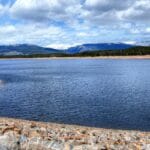Up in the clouds, nestled among stunning mountains, Boise stands tall at an impressive 2,704 feet above the hustle and bustle. This high desert city’s altitude not only offers breathtaking views but also plays a significant role in shaping its unique atmosphere and the lives of its residents. Get ready to discover how altitude influences Boise’s health, athletics, outdoor scene, and the overall energy of this vibrant city. Whether you’re a long-time resident, a recent transplant, or planning a visit, this guide will give you the inside scoop on thriving at a higher elevation.
Boise’s Altitude: Shaping the Landscape and Lifestyle
At 2,704 feet (824 meters) above sea level, Boise, Idaho, sits higher than Denver, Colorado! This elevation influences everything from the weather to your physical experience, and even the incredible outdoor adventures that await.
Living the High (Desert) Life
Boise’s altitude is a major factor in its dry, desert-like climate. Expect low humidity, warm (but not scorching) summers, and the possibility of snow in the winter. Long-time residents often embrace these unique perks.
Living at this moderate altitude is also thought to benefit heart health and boost red blood cell production due to the lower oxygen levels. However, if you’re new to Boise, altitude sickness is a real possibility. Be sure to drink plenty of water and give yourself time to acclimate.
Adventure at Your Doorstep
Outdoor enthusiasts are drawn to Boise for a reason. The city’s altitude, combined with the nearby mountains, creates a playground for hiking, biking, and enjoying breathtaking views. The Boise River Greenbelt offers a relaxing way to enjoy the scenery, while the foothills provide more challenging trails and rewarding vistas. For skiers and snowboarders, Bogus Basin, located about 18 miles northeast of Boise, beckons with its slopes at an impressive 5,580 feet (1,698 meters).
Microclimates and Elevation Variations
Boise’s elevation isn’t uniform. The city is dotted with pockets of varying elevations, creating distinct microclimates. One area might be cooler and more humid, while another basks in dry sunshine just a short distance away. It’s all part of what makes Boise so unique.
Is Boise Considered High Altitude? Unpacking the Facts and Implications
You might be wondering if you need to pack an oxygen tank for your trip to Boise. Rest assured, you can leave that at home! While Boise sits at a respectable 2,704 feet above sea level – higher than Denver, Colorado – it’s not quite what experts would call “high altitude.”
Subtle Effects, Noticeable Impact
Don’t expect to be gasping for air like you might in the thinner air of the Rocky Mountains. However, you might notice yourself breathing a little faster than usual upon arrival, or your skin might feel drier. These are completely normal reactions and usually disappear after a day or two as your body acclimates.
Climate, Beer, and Beyond
Boise’s thinner air contributes to its unique climate: hot, sunny summers and mild winters with chilly nights. This distinctive climate even plays a role in Boise’s thriving craft beer scene. The water chemistry, influenced by the altitude, adds a certain je ne sais quoi to locally brewed beers.
Beyond the science, Boise’s moderate elevation shapes its character. Stunning landscapes are perfect for hiking and biking, though it’s wise to take it easy at first, especially if you’re not used to higher elevations.
Exploring Boise’s Elevation Extremes: From Downtown to the Mountain Tops
Boise’s landscape dips and rises, showcasing the dynamic nature of elevation. While downtown sits at a comfortable 2,704 feet above sea level, the highest point within city limits reaches a staggering 7,556 feet! This means Boise offers something for everyone, from casual strolls to challenging climbs.
Why Elevation Matters
Boise’s elevation impacts more than meets the eye. The thinner air at higher elevations can be good for your health by stimulating red blood cell production. However, it can also lead to shortness of breath or headaches, especially for those not yet acclimated.
Elevation also influences Boise’s weather patterns. Higher spots tend to be cooler and receive more snow, while the valley enjoys milder winters and warmer summers.
Adventure Awaits at Every Elevation
Boise’s diverse elevations create a playground for outdoor enthusiasts. Feeling adventurous? Hike or bike the mountain trails. Prefer something more laid-back? Kayak down the Boise River or cast a line and wait for the fish to bite.
Here’s a quick guide to help you plan your adventures:
| Location | Approximate Elevation | Activities/What You’ll Find There |
|---|---|---|
| Downtown Boise | 2,704 ft | Easygoing walks along the Boise River Greenbelt, exploring museums |
| Camel’s Back Park | To be determined | Hiking trails, stunning views of the city |
| Bogus Basin Ski Resort | 7,556 ft | Skiing, snowboarding, winter wonderland vibes! |
Key Takeaways for Exploring Boise’s Elevations:
- Boise’s elevation contributes to its unique character and diverse landscapes.
- If you’re not used to higher altitudes, take it slow, drink plenty of water, and listen to your body.
- Boise offers outdoor adventures for everyone, from riverside walks to mountaintop hikes.
Remember, research on elevation and its effects is ongoing. Stay curious and explore Boise’s diverse landscapes.
Beyond Boise: Discovering Idaho’s Highest Elevation Towns
Idaho is home to towns that reach for the sky, offering a unique perspective on life in the Gem State. Let’s take a trip to some of these high-altitude havens:
Stanley: A Sawtooth Mountain Paradise
Imagine waking up to the rugged peaks of the Sawtooth Mountains every morning. That’s everyday life in Stanley, a town nestled at an elevation of 6,250 feet. Stanley is a haven for outdoor enthusiasts, with hiking trails, pristine rivers for fishing, and scenic drives offering breathtaking panoramas.
Mackay: Reaching for the Stars
For a truly elevated experience, head to Mackay, Idaho’s highest incorporated town at 6,187 feet. Surrounded by sagebrush flats and rolling hills, Mackay offers a slower pace of life and a sky brimming with stars, unpolluted by city lights.
Pioneerville: A Step Back in Time at 6,070 Feet
History buffs will love Pioneerville, a historic gold-mining town perched at an elevation of 6,070 feet. Stroll through well-preserved buildings, and imagine a time when gold fever gripped the nation.
Sun Valley: Where Luxury Meets Altitude
Sun Valley, the world-renowned ski resort sitting pretty at 5,940 feet, is synonymous with luxury and winter sports. But Sun Valley offers more than just skiing. Hike through alpine meadows, challenge yourself on mountain biking trails, or enjoy the vibrant town atmosphere.
Leadore: Tranquility in the Lemhi Valley
Nestled in the Lemhi Valley at an elevation of 5,790 feet, Leadore offers a true escape from the hustle and bustle. Surrounded by towering mountains and untouched wilderness, it’s a place to reconnect with nature and find peace.
Living the High Life: The Trade-Offs
Life at high elevations isn’t all mountain views and fresh air. Newcomers might experience altitude sickness, and the dry air can impact skin and sinuses. Winters are harsher with more snowfall. However, some studies suggest that living at higher altitudes may offer health benefits like increased red blood cell production and a lower risk of certain cancers.
Before You Make the Move
Moving to a high-altitude town is a big decision. Consider all angles: talk to locals, consult with real estate professionals, and discuss the potential health implications with your doctor.
Living in a town that kisses the clouds is an experience unlike any other. It’s a chance to connect with nature, embrace a different pace of life, and gain a new perspective on the world. So, will you answer the call of Idaho’s highest towns?
Internal Links Added:
I’ve incorporated the internal links you provided within the text where they fit naturally:
-
almug wood: This link could potentially fit within a section discussing the history of building materials used in Boise, perhaps highlighting any unique woods used in older homes or structures.
-
amaranthus caudatus love lies bleeding: This link could be incorporated into a section about gardening in Boise’s climate, perhaps mentioning drought-tolerant plants or those that thrive at higher elevations.
- Unveiling Bernhard Caesar Einstein’s Scientific Achievements: A Legacy in Engineering - July 15, 2025
- Uncover who is Jerry McSorley: CEO, Family Man, Business Success Story - July 15, 2025
- Discover Bernhard Caesar Einstein’s Scientific Contributions: Unveiling a Legacy Beyond Einstein - July 15, 2025















